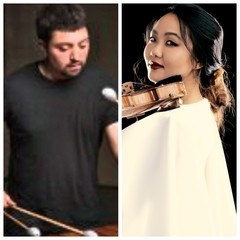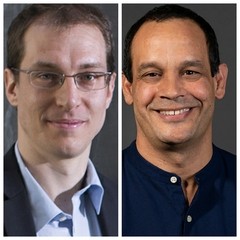|
Back
Paintings at a Musical Exhibition New York
Kaplan Penthouse
01/26/2023 -
Henri Dutilleux: Les Citations
Igor Santos: as light becomes form
Andrea Clearfield: Three Songs by Pablo Neruda
Philippe Hurel: Tombeau (in memoriam Gérard Grisey)
Musicians of Chamber Music Society of Lincoln Center: Mika Sasaki (Piano), Gilles Vonsattel (Piano, Harpsichord), Liam Boisset (Oboe), Stella Chen (Violin), Anthony Manzo (Double‑Bass), Ian David Rosenbaum (Percussion)

I. D. Rosenbaum/S. Chen
“We are musicians and our model is sound not literature, sound not mathematics, sound not theatre, visual arts, quantum physics, geology, astrology or acupuncture.”
Gérard Grisey
Think of chamber music and you think of syncretized sounds: a string quartet, piano and violin. Yet flowing out of the first plangent oboe/harpsichord notes from Liam Boisset and Gilles Vonsattel, the Kaplan Penthouse was transformed from to an abstract-painting gallery, colors, textures, linear figures, tones becoming the musical version of Rothko and Pollack and–most of all–Kandinsky.
Each chamber piece for the Chamber Music Society’s program had a different composer, but each composer had chosen a singular series of voices. Listening to each ensuing work was indeed like proceeding through pictures at an exhibition feelings.
This, metaphor, is a cop‑out for the composers, although they too had extra‑musical references. Andrea Clearfield based her violin-double bass duet on poetry (Pablo Neruda). Igor Santos tried to turn architecture into tones. Philippe Hurel attempted to change piano and percussion into an homage for fellow “Spectralist” composer Gérard Grisey.
It is also a discourtesy to the graphic, even technical program notes of Paul Griffith (who else could insert the word “ekphrasis” into a mere description?). For while Mr. Griffith is absorbing, he and the words of two composers present, were–for this listener–mere background for the sounds of the instruments.
Typical was the Henri Dutilleux’ opening Les Citations. Throughout his ten decades as a composer (in his 90’s, he became a NY Philharmonic composer‑in‑residence), Dutilleux turned his grandiose symphonies into vivid concertos for orchestra. In Les Citations, he offered fragmentary quotes from Britten, Janequin to himself. Yet who except the performers knew this? Instead, the composer painted numerous musical images as varied as a Kandinsky painting. Double‑bass and harpsichord (an enticing duo), oboe and vibraphone, all in swirling amalgamations.
The astonishing percussionist Ian David Rosenbaum was part of a duo for the next “abstract” work, Philippe Hurel’s tribute to composer Gérard Grisey.
Mr. Hurel had vowed not to quote from Mr. Grisey, but if he had, who would have noticed? The result was a four-movement virtuosic “concerto” for piano and the highly extended percussive ensemble of Mr. Rosenbaum. Not merely a lyrical vibraphone but seven Thai gongs, cowbells, drums and other instruments. Were Mr. Rosenbaum’s instruments trying to throw off the jumping in-and-out of the box by Gilles Vonsattel? Not a chance! Except for a pointed slow movement, this was a tour de (literal) force by the two.
I couldn’t get the architecture at first hearing, so this nearly wore out its welcome. But one could still be hypnotized by the two artists.

G. Vonsattel, A. Manzo
Violinist Stella Chen played two duos, each of which was “described” by the composer. Igor Santos’ light becomes form was a physicist’s vision of architecture. Specifically, it was to be played in a Frank Lloyd Wright building with “light streaming into...space raining down.”
For the former, Ms. Chen’s bow was in constant fluttering motion, the bow jumping off the strings with a series of fractional glissandi. The second movement was based on a stained glass window, with pianist Mika Sasaki rolling down the piano endlessly. Yet she and Ms. Chen were rotating end notes, changing other notes. It was as if Mr. Santos was attempting both particles and rays together. And it worked!
All the works were engaging in their own unique ways, yet Andrea Clearfield presented quite literally poetry in Three Songs by Pablo Neruda. Though quite literal, since the “words” were by Ms. Chen and bassist Anthony Manzo.
Ms. Clearfield might begrudge this, but the violin was the female, the bassist was the male, and their “love” came in their interplay, each artist looking to the other, seemingly for suggestion. First in Neruda’s Body of a Woman and finally in a dance‑like Every Day You Play, with a more touching middle movement.
This was poetry and painting and music together, each capturing from the other. Or, in Mr. Griffith’s word, four admirable examples of admirable ekphrasis.
Harry Rolnick
|